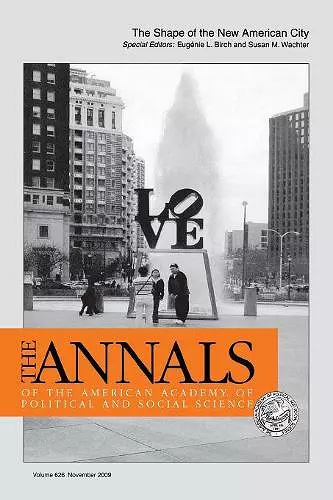The Shape of the New American City
Susan Wachter editor Eugenie L Birch editor
Format:Paperback
Publisher:SAGE Publications Inc
Published:22nd Dec '09
Currently unavailable, and unfortunately no date known when it will be back

What does the future hold for America′s cities and metropolitan areas? This special volume of The ANNALS analyzes demographic trends, housing preferences, crime patterns, economic indicators, and infrastructure investments to examine emerging patterns in the nation′s cities. Drawing on research by leading scholars, the volume points toward a growing metropolitan centralityand a slowing-down of the sprawling suburban growth of the last half century. In particular, contributors agree that cities with dense, walkable downtowns that agglomerate economic activity are poised for resurgence. Among the new—and surprising—findings:
- Susan M. Wachter and Richard Voith point to the remarkable turnaround of many of the thirty largest cities in 1970, which went from hemorrhaging to gaining population.
- Eugénie L. Birch shows how downtowns have experienced an uptick in residential activity that strengthens their economic and cultural viability.
- Ingrid Gould Ellen and Katherine O′Regan cite the dramatic decrease in urban crime over the last decade as a factor in luring the middle class back into urban areas—while making cities safer as well for disadvantaged and minority populations.
- Robert P. Inman and Andrew F. Haughwout provide evidence that suburban land values are increased by subsidies to their central cities and that the metropolitan area as a whole benefits from policies that increase the viability of the city at their core.
- Douglas Massey finds that while black-white segregation in metropolitan areas is loosening, there is increasing segregation on the basis of class.
- Robert Cervero shows that public transit can increase land values and improve neighborhood quality, as cities embark on new policies such as replacing elevated freeways with greenways and boutiques.
- Looking forward, Arthur C. Nelson predicts that the period from 2010 to 2030 will see a monumental demographic shift, with tremendous growth in the number of people over age 65 and a decline in the number of households with children. This shift, coupled with new housing preferences for residential units with transit accessibility and proximity to stores and restaurants, will lead to a "new urbanity." Nelson concludes that suburbs will have to change exclusionary zoning laws, property tax structures, and other policies in order to accommodate new housing demand.
- Dowell Myers and John Pitkin focus specifically on the effects of the impending retirement of the baby boom generation, arguing that the eventual housing sell-off among the boomers will create...
ISBN: 9781412981934
Dimensions: unknown
Weight: 370g
244 pages